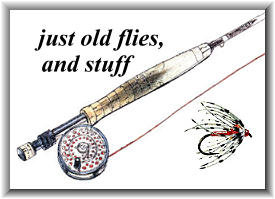Aside from having a name that evokes the
North Woods, and is companion to the well
known "Queen of the Waters," this fly has
one outstanding characteristic. It is
diabolically difficult to tie. I took a break
from wet flies after trying repeatedly to tie
this pretty thing, each effort ending in near
total failure. The married wing is the problem,
consisting of two shades of mallard with red
goose. Marrying mallard to mallard will put
your nerve, resolve, fortitude, patience, and
level of sheer insanity to the test. The insanity
thing I've got down, and after tying about 30 full
dress flies over a period of a couple of months
to get warmed up, I finally managed to tie this
fly. Now I can get on with my life.
A couple of tricks to tying this have to do with
the materials. First off, don't try to get a
perfect version of the King of the Woods in, say,
a size 14. Size 6 is a good size. Much smaller
and the mallard just won't stay together. You can
tie it smaller, the mallard will just be all over
the place. The other thing is to simply have the
right mallard. I started with a whole duck, and
still couldn't find pieces where the curves matched
well enough. I finally resorted to mallard sold by
salmon fly material vendors, like Ronn Lucas. Salmon
fly mallard is usually the cream of the crop, not
as curvy, very large feathers with lots of web, and
this helps the slip stay together. Above and beyond
these tricks, perseverance is everything.
Mr. A.N. Cheney, of Glens Falls, N.Y., brought this
fly to the attention of Mary Orvis Marbury. He is
best known for the fly "The Cheney," surprisingly
enough, and was editor of the fishing department
of Shooting and Fishing, an outdoor periodical
of the day. The King of the Woods was of unknown
origin, but was highly though of by guides in
northern N.Y., and they called it King of the
Woods, a backhanded reference to the "Queen of
the Waters." This fly is included with the lake
flies in Mary Orvis Marbury's book, Favorite
Flies and their Histories. The fly did not
appear to retain its popularity, as it was not
included in Ray Bergman's comprehensive collection
of wet flies found in his book from 1938, Trout.
Here is the recipe for The King of the Woods:
Tag: Gold Tinsel.
Tail: Scarlet and yellow goose.
Body: Yellow floss.
Rib: Gold Tinsel.
Wing: Pale mallard, (bottom) married
to brown mallard, red strips top each side.
Hackle: Dark green.
~ Eric Austin
Credits: Favorite Flies and Their
Histories by Mary Orvis Marbury;
Trout by Ray Bergman.
|

